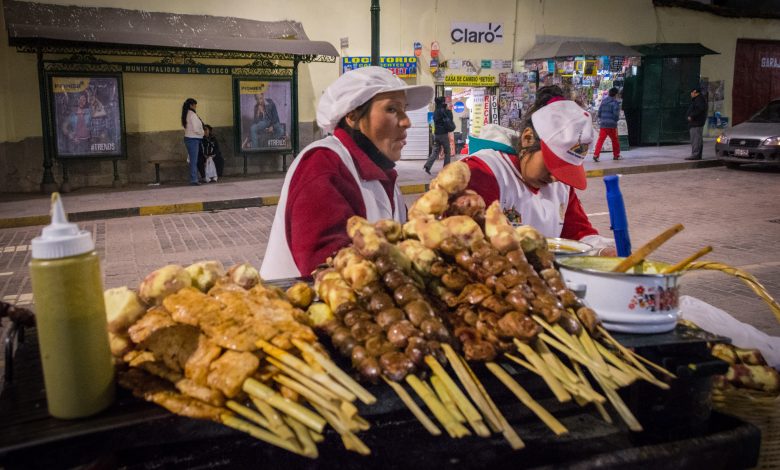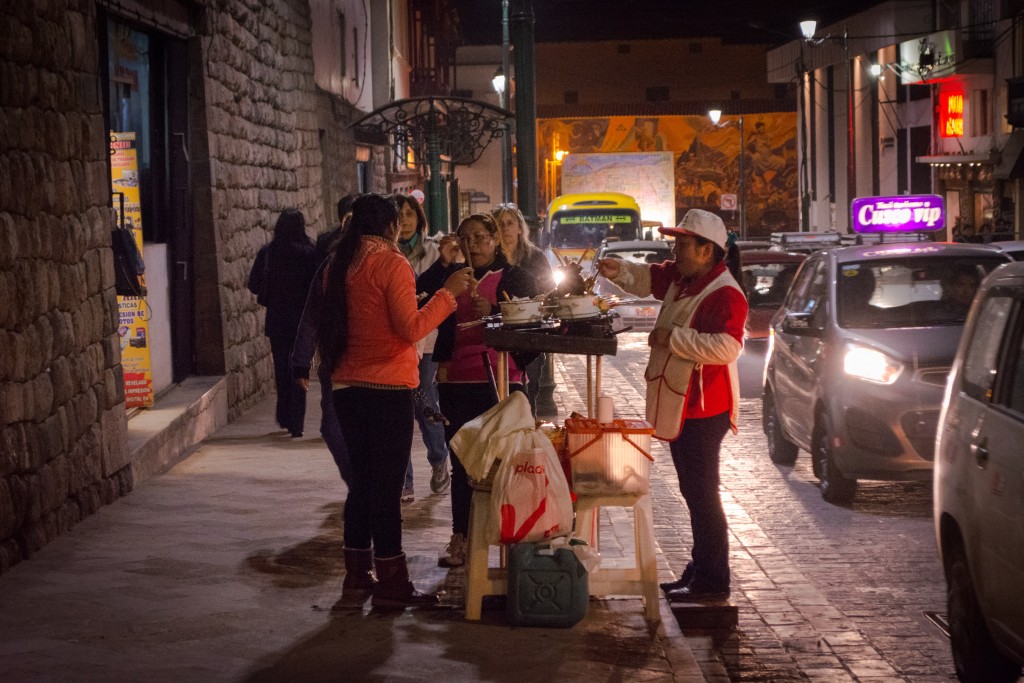Skewers of Meat, Anticuchos, Build Memories in Cusco

Anticuchos hold memories for the people of Cusco. They remind them of moments of fiesta lived in our city where everything is a carnival of colors. These brochettes of sharp-pointed cane sticks on which pieces of meat and a potato each are inserted are sold on the edges of every major public celebration as well as in the fairs that are organized throughout the year in the city. They also appear every evening in Cusco’s streets where they are a fixture of our night life. They especially typify the following streets: Matara, Tres Cruces de Oro, Almagro, Plateros, and Choquechaca. You will also find them at major bus stops and in some restaurants.
Beginning around 4 pm in Cusco you can see the caseras (the vendors) in their aprons of different colors, although most are white, begin to heat up their grills with carbon and alcohol until the coals become red. When all is ready they start cooking their anticuchos for sale. Their prices are very economical. Seasoned hotdog costs 2 soles, beef or chicken cost 3 soles, and beef heart is 5 soles. People who have not eaten many anticuchos may think the meat will eb tough or fibrous, but this is not true. Once they try it they will find it tender and juicy. They will even try to deduce the combination of herbs and spices that may have made it so tender and flavorful.
The caseras prepare the anticuchos with much dedication. They have to be very attentive for them not to dry out or burn. For this, they keep the aderezo, the seasoning mariade in which they prepared the meat and when they turn the anticuchos every so often they brush it on them with a brush made of corn husks that they have made for themselves. This is how they keep them so juicy while over the hot coals.
At night the scents of the different foods prepared and offered in the streets seduce passers by. There are salchipapas, pollipapas, fried chicken necks, and anticuchos. They are all found in the chilly nights of Cuzco and the combination with the smoke from cooking anticuchos draw us to the point of sale. There you can eat these pieces of meat and the aji–the hot sauce– for those who wish to add it to their anticuchos. The diners stand by the grill awaiting their perfectly cooked anticucho right by the side of the casera who is cooking it up for them. They form groups according to when they arrive so that the casera can attend their desires in an orderly fashiopn.

On Maruri street, every night the casera Ana Luisa can be found. She has sold anticuchos for some 35 years. She told me that during all this time selling every evening from 5 PM to 10 PM she has seen the different stores and other businesses in the area open and close their doors. “On this street”, she said those who worked in the businesses would always buy anticuchos from her. It was more. Some would ask me to take them to their stores. My caseros (regulars) still come by and buy from me.

“When the Cine Cusco (The Cusco Movie Theatre) was open some thirty years ago, the street would fill with long lines of people. From the door the line would reach San Agustin Street. At that time I sold well, some 15o anticuchos per night. Now I only sell some 50 and on weekends sales go up. On Thursday, Friday and Saturday I sell 75 anticuchos per night.”
I was fascinated with what she related. For so many years she had known the cold of night and the changing of the seasons. She served me up an annticucho of beef heart. It was as soft as bread fresh out of the oven and filled with flavor.
Out of curiosity I tasted the aderezo that she used to brush the cooking meat and that made it so juicy. I liked it a lot. So I asked her what it contained and how she made it. She said it had yellow aji. papaya, oil, garlic, and a bit of salt. “That is the sauce in which the sliced meat marinates and then in a big bowl I gather all the juices and use it so that the flavors of the meat annd the potato are distributed uniformly while they cook on the grill.”
The combination of the huayro potato and the spiciness of the aji, the hot sauce, reminded me of the anticucherias, anticucho restaurants, of Cusco called Condorito. One of them is located on the Avenida de la Cultura in front of the main door of the Regional Hospital. There, I remember, they served me two brochettes, one of meat and the other of heart. They brought my fork and knife together with napkins. Their aji (hot sauce) was wonderful, though it seemed to me a bit strong in garlic. But the green aji ot the casera Ana Luisa impressed me more. It drew me in like a steaming cup of coffee when you first store in the amount of sugar you like.
I asked the casera which was the ingredient that made her aji spicy and she told me with a smile “It is the peel of the hot rocoto pepper which I grind on a stone batan together with huacatay, garlic, cilantro, and peanuts, as well as bit of cheese. I always have to make up two large bottles of aji. The caseros (clients) like it. At the end of the day I always take home two empty bottles.
“Every morning I have to get up and go early to the San Pedro market to get the meat, the ingredients for the aji and for the aderezo. In the afternoon, after lunch, I begin to boil the potatoes. Then I slice up the meat and prepare the aderezo. I submerge the meat and then make up my aji. In this way time passes quickly until it is time to come and sell”, she concluded.
The scent of the potato and the meat remains on your fingers and makes you imagine everything turns around this delight. Ana Luisa has developed over her thirty years a great demand from the people of Cusco who continue with the tradition of eating anticuchos.
There is no single preferred place to have your anticuchos. People may eat them in restaurants, or on the street. Happy from enjoying my anticucho of beef heart and being able to chat with the casera I said “good-bye”. With good humor and a smile she told me to come back.




